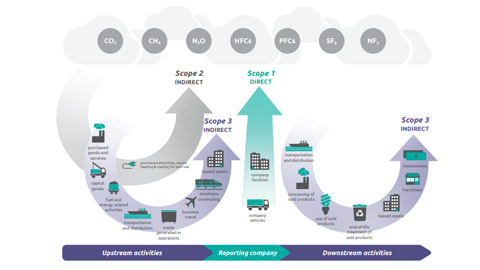The GHG Protocol first published its Corporate Standard in 2001 and last revised it in 2004. Its standards have defined internationally accepted best practices and are the basis for emissions management in many sectors. Greenhouse gases include six individual GHGs or classes of GHGs: carbon dioxide (CO2), methane (CH4), nitrous oxide (N2O), hydrofluorocarbons (HFCs), perfluorocarbons (PFCs), sulphur hexafluoride (SF6). However, changes to international accounting and reporting rules under the UNFCCC/Kyoto Protocol now also require the reporting of another GHG, nitrogen trifluoride (NF3).
SCOPE 1 – DIRECT EMISSIONSScope 1 emissions are DIRECT emissions from the company’s owned or controlled sources. They include:
- On-site energy like natural gas and fuel
- Refrigerants
- Emissions from combustion in owned or controlled boilers and furnaces
- Emissions from fleet vehicles (e. g. cars, vans, trucks, helicopters for hospitals).
- Process emissions that are released during industrial processes, and on-site manufacturing (e.g., factory fumes, chemicals).
Unlike direct emissions, the GHG Protocol defines indirect emissions as “a consequence of the activities from the reporting company but occur at sources owned or controlled by another company.” These include Scope 2 and Scope 3 emissions. However, the GHG Protocol makes a clear distinction between the two categories.
SCOPE 2 – INDIRECT EMISSIONSScope 2 emissions are INDIRECT emissions from purchased energy. They include :
- indirect greenhouse gas emissions from purchased or acquired energy.
According to the GHG Protocol scope 2 emissions represent one of the largest sources of global greenhouse gas emissions accounting for at least a third of it. That is why assessing and measuring Scope 2 emissions present a significant emissions reduction opportunity. But what do these emissions include?
SCOPE 2 – INDIRECT VALUE CHAIN EMISSIONSScope 3 includes all INDIRECT emissions that OCCUR IN THE VALUE CHAIN of a reporting company.
To make a clear distinction between Scope 2 and Scope 3 categories the US Environmental Protection Agency (EPA) describes the Scope 3 emissions as “the result of activities from assets not owned or controlled by the reporting organization, but that the organization indirectly impacts in its value chain.” Even though these emissions are out of the control of the reporting company, they can represent the largest portion of its greenhouse gas emissions inventory.
Based on the financial transactions of the reporting company, the GHG Protocol divides the scope 3 emissions into Upstream and Downstream emissions.
- Upstream emissions encompass the indirect greenhouse gas emissions within a company’s value chain related to purchased or acquired goods (tangible products) and services (intangible products) and generated from cradle to gate.
- Downstream emissions include the indirect greenhouse emissions within a company’s value chain related to sold goods and services and emitted after they leave the company’s ownership or control.
